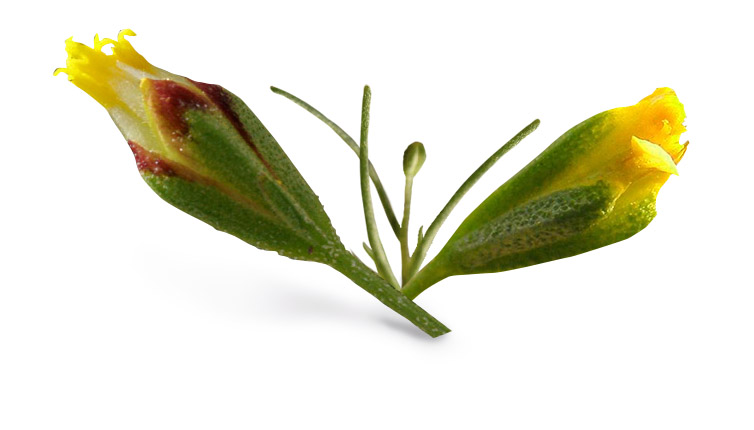Canchalagua - Schkuhria pinnata

Common Names: Canchalagua, canchalahua, kanchalawa, jayajpichana, escobilla, escoba de anisillo, anisillo cimarron, khakibush, mata-pulgas, pinqui-pichana, pinnate false threadleaf, tacote, starry skies, tumbleweed, dwarf marigold, dwarf Mexican marigold, akech, azureta, schkuhria, karatataraku putsutiri, purépecha, pichana, kanchlawa, kuti pichaňa, Schkuhria pinnata (Latin), Canchalagua (Spanish, English, global), Schkuhria
Latin Name: Schkuhria pinnata
Origin: Africa, South America, North America
Short Introduction
Unfortunately, there is little information available about the proper cultivation of Canchalagua in European conditions. There are also no reports of farmers or gardeners in the Czech Republic attempting to grow this plant in local surroundings.
Detailed Description
A traditional Peruvian herb with broad-spectrum cleansing and detoxifying potential.
Botanical Information
Canchalagua (Schkuhria pinnata) is an upright annual herb with an unassuming appearance, typically reaching about 50 cm in height. The plant features slender, woody stems as it matures, and simple leaves up to 4 cm long, which may be lobed or not, arranged oppositely in pairs at each node. The leaf margins are notched or toothed. Its flowers are extremely small, yellow, and disc-shaped, yet the plant bears them abundantly.
Origin and Distribution
Native to South America, Canchalagua thrives mainly in the dry, mountainous regions at altitudes of 2,000–3,000 meters above sea level. It is found abundantly in the Andean valleys (especially in modern-day Peru). Eventually, through human activity, it spread and was cultivated in other places such as Mexico, Bolivia, parts of the southern United States (Texas, Arizona), Africa, and Latin America.
Canchalagua commonly grows on mountain slopes and embankments near agricultural buildings and wild thickets. Some sources cite its occurrence as high as 3,800 meters above sea level in the central to eastern Cordillera ranges.
Usage / Dosage
In Peruvian folk medicine, Canchalagua is a valued herbal remedy for liver and kidney complaints (supporting the general excretory system), as well as for malaria, diabetes, allergies, yeast infections, prostate inflammation, digestive issues, bloating, rheumatism, and skin conditions such as acne, dermatitis, and eczema. Folk healers use the aerial parts to purify the blood; externally, it’s applied for pimples, acne, and eczemas, and internally as a diuretic and antibiotic for urinary tract infections.
In African herbalism, Canchalagua is used for stomach complaints, gastritis, and malaria. For example, in Kenya, it’s considered helpful for stomach pain. South American indigenous peoples have long used Canchalagua’s aerial parts for malaria, fevers, and as an antispasmodic for smooth muscle cramps. In Argentina, it is recommended for diarrhea, respiratory infections, systemic cleansing, antibacterial purposes, and as a slimming aid. In border regions of Bolivia and Peru, it’s used to support weight loss, digestive troubles, and yeast infections in women. In Bolivia especially, Canchalagua is employed for inflammatory disorders of the urinary tract. In Paraguay and across parts of Latin America, it’s even used as an insect repellent.
The plant is listed in the third edition of the Mexican Pharmacopoeia for its antispasmodic effects. In traditional medicine, it is taken internally to regulate menstruation, support visual health, aid liver and gallbladder complaints, fight malaria, treat yellow fever, and provide general systemic cleansing. Externally, it is used as a wash for wounds and cuts.
The original inhabitants of the Andes (the Ketchwa people) named the plant Canchalagua, as it had been used with great success for blood purification for centuries. The aerial parts are typically prepared by removing the root, chopping the herb, and then boiling it fresh or making an infusion of the dried plant for external use. It is commonly used for skin problems caused by toxins or bacteria—such as eczema, dermatitis, or acne—by cleansing the blood and targeting underlying imbalances.
In Peruvian herbal tradition, Canchalagua is recognized for its anti-inflammatory, digestive, and antitussive (cough-relieving) effects, and is used as a tonic, diuretic, and hypoglycemic agent. It is recommended for mild cases of diabetes, allergies, yeast infections, prostate inflammation, digestive disorders, bloating, rheumatism, as well as the aforementioned skin issues.
About six scientific papers have been published investigating select compounds in the aerial parts of Schkuhria pinnata and similar plants for their anti-inflammatory and antipyretic activities compared to standard inflammation markers such as tumor necrosis factor-alpha, interleukin-6, heme oxygenase, nitric oxide production, and more.
Other studies have documented antispasmodic effects of Canchalagua’s constituents, particularly in alleviating mild gastrointestinal cramping in adults. Research also explores the plant’s content for potential inhibitory action against various bacterial, fungal, and yeast infections.
Additional studies in laboratory animals suggest compounds from Canchalagua may modestly aid in improving diabetic symptoms in rats. Many papers focus on the cytotoxic and anti-cancer activities of its compounds, leading to diverse interpretations in the scientific literature.
Active Compounds
The aerial parts contain a diverse array of compounds, including germacranolides, sesquiterpene lactones, sulfur-containing substances, flavonoids, and heliangolides. The anti-inflammatory effect is mainly attributed to costunolide, known for inhibiting the activity of tumor necrosis factor kappa B, reducing nitric oxide effects, and potentially optimizing glycemic parameters.
Other notable compounds involve pectolinarigenin (with both strong anti-inflammatory and antispasmodic effects), chromolaenide, dithiin, eucannabinolides, hiyodorilactones, loliolide, schkuhrianol, nerol, schkuhripinnatolides, schkuhrins, costunolides, chromolaenolide, santhemoidin A, thiarubrin A, thiophene, tridecapentayne, and zaluzanin C.
Traditional Dosage
The most popular way to use Canchalagua is as a classic herbal infusion (tea). Use one teaspoon of powder or about half a teaspoon of dried aerial parts per cup of water. Pour boiling water over the herb and allow it to steep for around 10 minutes. Drink hot. In folk medicine, 1 cup of the infusion is consumed 2–3 times daily. Other traditional sources suggest adding about a third of a cup of dried Canchalagua to roughly a liter of cold water, boil for 5 minutes, let cool briefly, strain, and drink warm; the remaining infusion can be stored in the fridge and sipped throughout the day as a refreshing tea. Lemon, cinnamon, orange, honey, or sugar can be added for taste.
